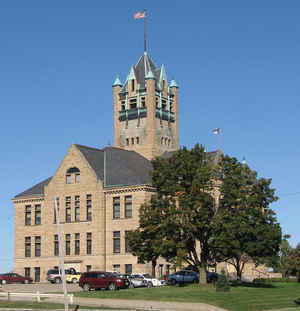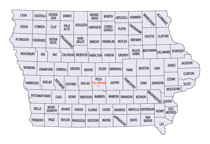Iowa Counties
There are ninety-nine counties in Iowa. The first two counties, Des Moines County and Dubuque County, were created in 1834 when Iowa was still part of the Michigan Territory. In preparation for Michigan's statehood, part of Michigan Territory was formed into Wisconsin Territory in 1836]. Two years later, the western portion was split off to become Iowa Territory. The south-eastern part of Iowa Territory became Iowa, the 29th state in the union, on 28 December 1846, by which point 44 Counties had been created. Counties continued to be created by the state government until 1857, when the last county, Humboldt County, was created.Johnson County, Iowa
Johnson County Education, Geography, and History
Johnson County is a county located in the state of Iowa. Based on the 2010 census, the
population was 130,882 making it the fifth-most
populous county in Iowa. Johnson County was created on
December 21, 1837. The county seat is Iowa City, home of the University of Iowa. The county is
named for Richard Mentor Johnson, the
ninth vice president of the United States.
Johnson County is included in the Iowa City, IA Metropolitan Statistical Area, which is also included in the Cedar Rapids-Iowa City Corridor
Combined Statistical Area.
Etymology - Origin of Johnson County Name
Johnson county is named for Richard Mentor Johnson, the ninth vice president of the United States.
Demographics:
County QuickFacts: CensusBureau Quick Facts
Johnson County History
Johnson County is named for Colonel
Richard Mentor Johnson and not Andrew Johnson, as some believe. Colonel Johnson
was in the War of 1812, senator from Michigan and the vice-president of the US
during the Van Buren administration.
Until the late 1830s the area known today as Johnson County was nothing more
than wilderness and a hunting ground for the Fox and Sac Indians. Between 1832
and 1837 the Indians were stripped of their lands by treaty. Soon settlers began
to move into the county. The county was established in 1837. By 1838 there were
two towns competing for the county seat--Osceola and Napoleon. An Act of the
Wisconsin Assembly selected Napoleon as the county seat on June 22, 1838. A
two-story log cabin courthouse was then constructed at Napoleon.
When the First Legislative Assembly of the Territory of Iowa met at Burlington a
bill was approved to locate the seat of government for the Territory of Iowa.
The site was to be within the boundaries of Johnson County, and it was to be
named Iowa City. Three commissioners met and selected a site two miles north of
Napoleon on May 1, 1839.
On December 31, 1839, an Act was passed to relocate the county seat of Johnson
County with orders to keep present and future populations in mind. The site of
the new county seat was easily chosen as Iowa City, the "capital" of the Iowa
Territory. In January 1855, the Fifth General Assembly voted to move the state
capital to Des Moines.
The first courthouse built in Iowa City was a temporary two-story structure
constructed of bricks. This courthouse burned to the ground in 1856. In 1857
this building was replaced by another courthouse, which was insured for $30,000.
This brick building was used until 1899, when it was condemned.
The cornerstone of the present courthouse was laid on December 2, 1899. It was
constructed by James Rowson and Son at a cost of $135,000. Bands, balloons and a
parade were part of the dedication ceremonies held on June 8, 1901.
Geography: Land and Water
As reported by the Census Bureau, the county has a total area of 623 square miles (1,610 km2), of which 614 square miles (1,590 km2) is land and 9.1 square miles (24 km2) (1.5%) is water.
Johnson county is located in east Iowa.
Neighboring Counties
Bordering counties are as follows:
- North: Linn County
- Northeast: Cedar County
- Southeast: Muscatine County; Louisa County
- Southwest: Washington County
- West: Iowa County
- Northwest: Benton County
Education







